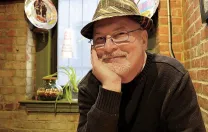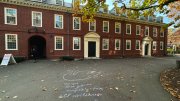This January a long-defunct bus garage on a weedy 8.5-acre lot in Roxbury, one of Boston’s poorest neighborhoods, is slated to be demolished. Then Bartlett Yard will become Bartlett Place. Plans for the $140-million development project call for 323 mixed-income housing units (including some slated for the elderly and artists), a grocery store, and offices, along with a public plaza.
The site is a short walk from Roxbury’s main commercial district, Dudley Square, and is expected to play a major role in the area’s much-debated, slowly emerging revitalization. The City of Boston is integral to the pending renewal, as is Boston Community Capital (BCC), based in the square. “Bartlett Yard was a polluted site, with bus fumes, and where repair work was being done in the garages, so you have a lot of paint and oil and gasoline—not a great environmental asset to have in the middle of a neighborhood,” says DeWitt “Dick” Jones ’79, M.C.R.P. ’82, the executive vice president of BCC, which is funding a portion of Bartlett Place. “The private developers were not chomping at the bit to do anything with it.”
In stepped one of BCC’s clients, the nonprofit Nuestra Comunidad Development Corporation, which bought the property and is leading the development of Bartlett Place. (Nuestra is, coincidentally, led by another alumnus, David Price ’77; “Striving For ‘A Real Mix of People,”) “You needed an organization like Nuestra,” Jones explains, “to do something that is appropriate and balances Dudley’s needs—making housing affordable for the people who are here and want to stay, and making something attractive that also brings in new residents and creates more positive momentum around change.”
Roxbury has a rich Colonial history, and was later home to waves of European immigrants. It is now predominantly African American, but Dudley Square has a vibrant mix of Brazilians, Asians, Africans, Latin Americans, and West Indians, all of whom shop at Tropical Foods, an international grocery. That mix, along with newcomers like artists and Square office workers, is also seen at the Haley House Bakery, a cozy café down the street that is run by a soup kitchen and staffed by people who “face significant barriers to employment.” On the other side of the square, though, both the three-year-old police station and the nearby library, Jones notes, look like attractive fortresses. Roxbury has had a reputation as a high-crime zone where economic opportunity is largely absent.
In 1998, to directly support and spur confidence in community rebuilding efforts, BCC moved into the second floor of Palladio Hall in the heart of the square. It is a grand 1870s Italian Renaissance-style structure left over from the neighborhood’s heyday. “When we got here,” Jones reports, “we were told we were the first tenant to move above the ground-floor commercial space in Dudley Square in two decades.” BCC helped finance extensive renovations (much of BCC’s space was once a ballroom), completed by Nuestra, which owns and also works out of the building. Elsewhere around the square, BCC has invested in daycare centers, health clinics, affordable housing, and a community assisted-living facility that took over a vacant elementary school.
Reflecting on BCC’s presence in Dudley Square—just one of the firm’s projects—Jones says, “If you rely on government subsidies or grants, and do not have financial returns, the work you can do is severely limited by scale, and it’s very hard to try anything new.” If he didn’t foresee delving into finance, Jones has always wanted to work for social change. As an undergraduate, he concentrated in government and remembers reading an article on bank redlining that led him to study capital markets to try to identify what factors created economically healthy communities. He then earned a master’s degree in city and regional planning from the Kennedy School. (His mother, Megan Jones, who had worked in state politics, was earning her M.P.A. around the same time.)
After graduation, he became the executive director of an advocacy organization, the Massachusetts Urban Reinvestment Advisory Group Inc. (MURAG), where he had also been an AmeriCorps VISTA volunteer. There, he met others working on economic development, including those in the midst of forming the Boston Community Loan Fund. They hired him to build the organization from scratch: Jones recalls running it from his attic, starting with $3,500 loaned to a day-care center, tenants’ group, and a women’s shelter. Since then, the community-development financial institution has invested more than $900 million in New England and around the country in support of its mission: “Building healthy communities where low-income people live and work.”
BCC’s loan fund now lists more than a hundred investors, ranging from larger institutions—such as Harvard, regional and national banks, and charitable foundations—to church groups, small nonprofits, and individuals. They lend money to BCC and get it back at fixed interest rates ranging from 0 to 4.5 percent, like investing in bonds. BCC then lends that money to borrowers at higher rates to cover the returns as well its own costs. The enterprise requires a precise balancing of monetary interests in the name of social justice. “We absolutely are not against making money, being profitable, and turning down projects and loans that are not likely to be successful,” Jones reports, but neither is the organization “scouring low-income communities for great money-making opportunities, or even medium ones.” A separate venture-capital unit, which offers higher returns, was an early backer of Zipcar, and has since invested in 22 other start-ups (not all as successful as the innovative car-sharing company), as well as other more established firms.
More recently, BCC has launched a mortgage-buyback initiative and two projects to improve energy efficiency. The SUN (Stabilizing Urban Neighborhoods) Foreclosure Prevention Program, which has focused on Massachusetts, but is being expanded across the country, uses investor financing to buy at-risk homes from banks at slightly below the market value and then resell them to the original owners at carefully underwritten, affordable mortgage rates. “Our customers,” Jones explains, “typically have been foreclosed upon but not yet evicted, want to stay in their homes, and have the income to support a ‘right-sized’ mortgage—at the current market value—but they are significantly under water and cannot pay the inflated housing and mortgage values.” The real market value—the best price a bank could get selling the property after foreclosure—is based on what local incomes can support, he adds, which is often “50 percent of what the peak prices were.”
BCC makes the mortgages from a combination of funds it has borrowed from investors, lenders, and banks. “We repay the principal on the loans to us when the mortgages are repaid or by establishing a secondary market,” he adds, as BCC recently did with a $35-million transaction with East Boston Savings Bank. To date, according to Jones, SUN has helped more than 425 households avoid eviction by decreasing their total mortgage payments by $30 million, typically by reducing principal amounts that cut total monthly payments by about 40 percent over the life of the loan.
During the last six years, Jones has moved away from direct involvement in affordable housing to develop and lead BCC’s environmental projects, work he takes personally. “We had been looking at how we could adopt the Kyoto Treaty at home,” explains Jones. He lives in Jamaica Plain, which abuts Roxbury, with his wife, Victoria Bok, M.P.P. ’87, a consultant on public housing and community engagement in climate change (and the daughter of former University president Derek Bok) and their teenage sons, Cameron and Nicholas. They turned off lights more often, bought a highly efficient boiler, fixed leaks in their chimney, exchanged their minivan for a Prius, and pledged to drive less. They also had the house scrutinized for air leaks, then filled them with insulating foam.
“On the heating side now, we are more comfortable and warmer in the winter and cooler in the summer,” he says, “so we don’t even use air conditioning.” All told, they cut their household carbon footprint by 50 percent, earning the City of Boston’s Green Residential Award in 2008. A year later Mayor Thomas Menino appointed Jones to the Renew Boston Advisory Committee, which oversees the city’s energy-efficiency programs.
Although clearly global in nature, environmental and energy issues deeply affect local, poor communities. In urban development, Jones states, “Climate change will drive everything in the future.” He leads BCC’s Solar Energy Advantage, which owns and installs photovoltaic solar panels on low-income housing, and other organizations in its portfolio, and is one of the founders and the board chairman of the completely separate venture, WegoWise, a start-up, for-profit software company that tracks buildings’ energy efficiency. He can talk at length about the complex political, economic, legal, and financial factors that govern solar power and other alternative energy sources—and their effects on inner-city areas. Jones jokes that the knowledge sometimes makes him questionable company at parties, but in practice, his expertise and detail-driven mindset have made BCC one of the largest nonutility owners of solar photovoltaic systems in Massachusetts. The 12,000 panels now in use have so far generated more than 9.6 million kilowatt hours, equivalent to the annual energy needed to power 500 homes. In short, Jones says, BCC lessens the environmental impact of its own buildings while saving a projected $3.4 million in “fixed-price, below-market electricity” costs to its customers over the life of the panels.
As important, he adds, is how the program integrates low-income communities into the green economy, often seen as a rich person’s luxury. “When you start to look at the high cost of hospital emergency-room visits due to asthma in low-income households, where there is mold in the walls and old carpeting and bad air quality in the homes” in addition to neighborhood pollution, Jones notes, “you see the relationship between personal health, home health, environmental health, and the economy.”
Founded in 2009 by BCC, New Ecology, and MIT alumnus and entrepreneur Barun Singh, WegoWise has developed tools that offer online, visual, automated utility-use tracking for property owners and managers. The company uses inexpensive cloud-computing infrastructure to download information from utilities’ websites, explains Jones, without relying on physical meters (the so-called smart grid, or hardware). WegoWise has so far created a database of more than 13,200 buildings, located across the country, though primarily in Massachusetts, New York, and California. It is the largest of its kind in the United States, he notes: “and a great use for big data.” BCC has invested nearly $3 million in WegoWise and plans to expand the company’s reach.
While at BCC, Jones has also worked on economic development in many other roles. He is a founding member of the Opportunity Finance Network; a former board member and treasurer of the Center for Women and Enterprise; and a current trustee at Boston Day and Evening Academy, a charter high school in Roxbury that serves nontraditional students.
As he guided a recent walk around Dudley Square, it’s clear that he sees a community in transition. Already under way is another vital development: the city’s long-promised $115-million redevelopment that includes turning the stately Ferdinand Building (at one time a prominent department store, it has stood empty for three decades) into the rechristened Dudley Municipal Center. The Boston Public Schools administrative staff, some 450 employees, could move into the new facility as early as this year—bringing more life and shoppers to the local streets.
The key to viable community development, Jones makes clear, is stimulating sustainable economic growth without displacing existing residents and tearing up what’s dynamic about a community’s culture. “We have to form a balance, and ask ourselves, ‘How do we want to make an economy in a city grow?’” he says. “If you look at how we think about schools and public safety and food and retirement and health care, it all has to work together. When communities get disaggregated, they fall apart, and then we all have a weaker civil society.”










